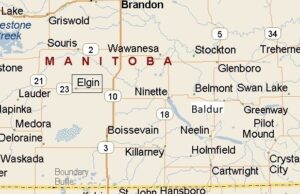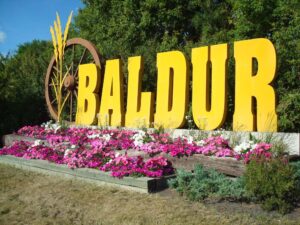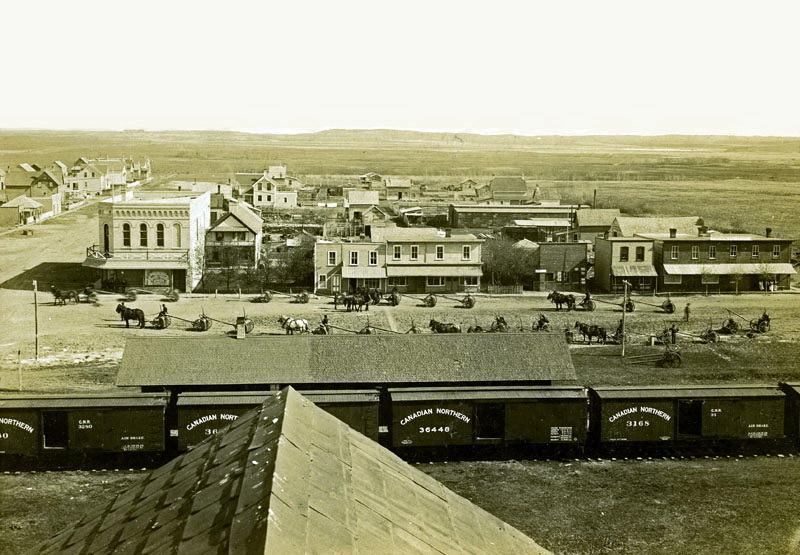
The Icelandic settlement, which stretched from Glenboro south to Baldur, was called the Argyle Settlement.
 In 1880 it was clear that settlers in New Iceland wanted to leave the settlement on Lake Winnipeg and some chose to follow Reverend Páll Thorláksson south to N. Dakota while others sought out the plains south and west of Winnipeg in Manitoba. In the years 1880-1886, the number of settlers on the plains increased greatly and the need for improved transport was great. In 1886 a railroad was laid from Winnipeg west to Glenboro, and now farmers in the area had easy access to Winnipeg markets. In 1889, another railroad was laid west of Winnipeg, about 20 miles [29 km] south of the Glenboro station. Next to that railway a village was formed which was named Baldur. There is a story about the naming. One of the first settlers in the settlement was Sigurður Kristófersson from Ytri-Neslöndum by Mývatn. He married a Canadian woman, Caroline Taylor, in New Iceland in the summer of 1877. The railroad company asked Icelanders to name the train station where the village was being formed and Caroline will have suggested Baldursbrá (an Icelandic flower). The English-speaking majority in the province found it rather long and difficult to pronounce, and then Baldur was suggested, it would be appropriate because of Nordic mythology. It is worth mentioning that the word Baldursbrá was used in the village, it was given to the Icelandic women’s association. Sigurður Kristófersson opened a small shop in his home early in the settlement period, but after the railway was laid to Glenboro, it ceased operations. Kristján Jónsson, who moved west from Héðinshöfði in Tjörnes in 1874, moved from New Iceland to the Argyle Settlement and soon opened a store in Baldur. He sold all kinds of agricultural equipment and tools there, while his father Jón Björnsson also ran a small bookstore. Other young Icelandic men later worked for other shop owners and service companies.
In 1880 it was clear that settlers in New Iceland wanted to leave the settlement on Lake Winnipeg and some chose to follow Reverend Páll Thorláksson south to N. Dakota while others sought out the plains south and west of Winnipeg in Manitoba. In the years 1880-1886, the number of settlers on the plains increased greatly and the need for improved transport was great. In 1886 a railroad was laid from Winnipeg west to Glenboro, and now farmers in the area had easy access to Winnipeg markets. In 1889, another railroad was laid west of Winnipeg, about 20 miles [29 km] south of the Glenboro station. Next to that railway a village was formed which was named Baldur. There is a story about the naming. One of the first settlers in the settlement was Sigurður Kristófersson from Ytri-Neslöndum by Mývatn. He married a Canadian woman, Caroline Taylor, in New Iceland in the summer of 1877. The railroad company asked Icelanders to name the train station where the village was being formed and Caroline will have suggested Baldursbrá (an Icelandic flower). The English-speaking majority in the province found it rather long and difficult to pronounce, and then Baldur was suggested, it would be appropriate because of Nordic mythology. It is worth mentioning that the word Baldursbrá was used in the village, it was given to the Icelandic women’s association. Sigurður Kristófersson opened a small shop in his home early in the settlement period, but after the railway was laid to Glenboro, it ceased operations. Kristján Jónsson, who moved west from Héðinshöfði in Tjörnes in 1874, moved from New Iceland to the Argyle Settlement and soon opened a store in Baldur. He sold all kinds of agricultural equipment and tools there, while his father Jón Björnsson also ran a small bookstore. Other young Icelandic men later worked for other shop owners and service companies.

This picture of Baldur shows the village clearly, you can see farmers pulling mowers etc. and a train by the railway station. Photo: Prairie Towns
